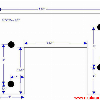dfox52
Active Member
- Joined
- September 12, 2015
- Messages
- 50
- Reaction score
- 18
- Year, Model & Trim Level
- 2013 Explorer XLT
So I had our 2013 Explorer in for some maintenance and the mechanic told me that I had a VERY bad wheel bearing on one of the rear wheels. He took me for a ride so we could listen it. It is loud, and it has been loud for a while, but I attributed the noise to the snow tires... In fact the noise sounds like you would expect aggressive tread to sound on pavement. He did not put it up on the lift or inspect it, he diagnosed it entirely by the sound from the rear. It's a 2013 XLT with 153,000 miles and the wheel bearings have never been replaced. So I accepted his diagnosis, took the vehicle home, put it up on jack stands. I tried turning and yanking the wheels back and forth to see if there was any movement or unusual sound from either wheel but I found nothing. Both wheels turn smoothly and make no sound. So I pulled the wheels, calipers, and rotors to try and get a better look. I'm down to the bare hub on both sides but there is still no movement, slop, or unusual sound from either wheel. So my question to folks... Is it possible to tell for certain if the wheel bearings are bad without actually pulling them? (which I hear can be a nightmare on these Explorers). I don't drive it much. maybe 1,000 miles a year, so I really don't want to get into time and expense of pulling the wheel bearings if there is still life in them. Any thoughts would be much appreciated!










